JSP安全开发之XSS漏洞详解
前言
大家好,好男人就是我,我就是好男人,我就是-0nise。在各大漏洞举报平台,我们时常会看到XSS漏洞。那么问题来了,为何会出现这种漏洞?出现这种漏洞应该怎么修复?
正文
1.XSS?XSS?XSS是什么鬼?
XSS又叫跨站脚本攻击(Cross Site Scripting),我不会告诉他原本是叫CSS的,但是为了不和我们所用的层叠样式表(Cascading Style Sheets)CSS搞混。CSS(跨站脚本攻击),CSS(层叠样式表)傻傻分不清。所以就叫XSS咯。
2.XSS的危害是什么?
实验一:
0x00构造代码
<%@ page language="java" import="java.util.*" pageEncoding="UTF-8"%>
<%
String path = request.getContextPath();
String basePath = request.getScheme()+"://"+request.getServerName()+":"+request.getServerPort()+path+"/";
%>
<!DOCTYPE HTML PUBLIC "-//W3C//DTD HTML 4.01 Transitional//EN">
<html>
<head>
<base href="<%=basePath%>">
<title>My JSP 'index.jsp' starting page</title>
<meta http-equiv="pragma" content="no-cache">
<meta http-equiv="cache-control" content="no-cache">
<meta http-equiv="expires" content="0">
<meta http-equiv="keywords" content="keyword1,keyword2,keyword3">
<meta http-equiv="description" content="This is my page">
</head>
<body>
<div style="margin: 0 auto">
<%
//设置编码
request.setCharacterEncoding("UTF-8");
//接收用户传入值
String tmp = request.getParameter("opr");
//减速传入值是否为空
if(tmp == null){
out.print("111");
}else{
//转码
String opr = new String(tmp.getBytes("ISO-8859-1"),"utf-8");
out.print(opr);
}
%>
我是内容
</div>
</body>
</html>
0x01环境布局

0x02漏洞演练
我们访问:http://localhost:8080/XSS/index.jsp?opr=i%E6%98%A5%E7%A7%8B

然后访问:http://localhost:8080/XSS/index.jsp?opr=0nise

最后我们发现了一个“伟大的规律”:
opr参数等于什么页面就打印什么。(好像是废话)
我们接着来加载一个图片看看
访问:http://localhost:8080/XSS/index.jsp?opr=%3Cimg%20src=%221.png%22%3E%3C/img%3E

既然图片都可以加载,那么我们JS文件是不是也阔以加载呢?
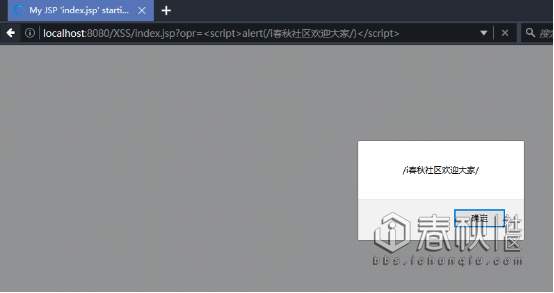
Js?Js?那么是不是可以来改变跳转后地址?

既然xss都可以加载js,那么,我们是不是通过js来打开本地的某些东西?
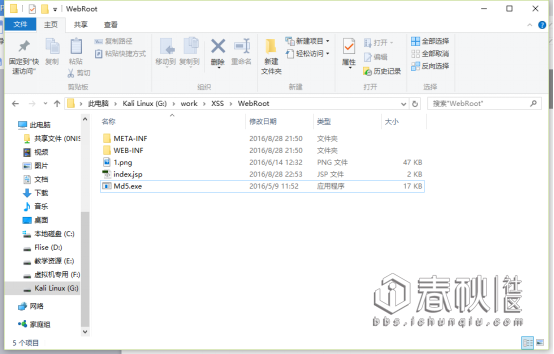
提前放了一个MD5.exe文件
访问:http://localhost:8080/XSS/index.jsp?opr=<script> var objShell = new ActiveXObject("wscript.shell");objShell.Run("G:/work/XSS/WebRoot/Md5.exe");</script>

既然连本地文件都可以打开那么远程文件木马?来个电脑恶搞?这个自己慢慢象限。我可没说啊。。。。。
文件都可以打开,那么写一些文件呢?
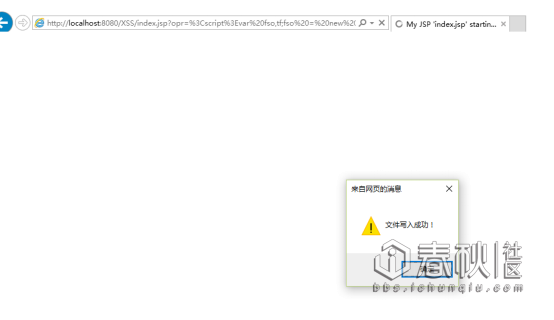

通过以上实验我们可以看出opr参数赋值操作。如果opr参数没有值的话,就无法执行执行,被攻击者必须访问攻击者提前设计好的才能攻击。这种XSS攻击方式叫做:存储型XSS
如果你想看到更给力的实验,请接着往下看。
实验二:
前言:
大部分网站都会和数据打交道那么,XSS漏洞出现这些网站是什么样子的?
0x00构造代码
数据库部分

BaseDao.java
import java.sql.Connection;
import java.sql.DriverManager;
import java.sql.PreparedStatement;
import java.sql.ResultSet;
import java.sql.SQLException;
import java.sql.Statement;
public class BaseDAO {
//打开连接
public Connection getConn(){
Connection conn = null;
try {
Class.forName("com.microsoft.sqlserver.jdbc.SQLServerDriver");
conn = DriverManager.getConnection("jdbc:sqlserver://localhost:1433;databaseName=SQLTMP","sa","sa");
} catch (ClassNotFoundException e) {
e.printStackTrace();
} catch (SQLException e) {
e.printStackTrace();
}
return conn;
}
//关闭链接的方法
public void closeAll(Connection conn,Statement stat,ResultSet rs){
try {
if(rs != null)
rs.close();
if(stat != null)
stat.close();
if(conn != null)
conn.close();
} catch (SQLException e) {
e.printStackTrace();
}
}
//重载关闭方法
public void closeAll(Connection conn,PreparedStatement pstat,ResultSet rs){
try {
if(rs != null)
rs.close();
if(pstat != null)
pstat.close();
if(conn != null)
conn.close();
} catch (SQLException e) {
e.printStackTrace();
}
}
//继续重载
public void closeAll(Connection conn,PreparedStatement pstat){
try {
if(pstat != null)
pstat.close();
if(conn != null)
conn.close();
} catch (SQLException e) {
e.printStackTrace();
}
}
//增删改的公用方法
public int upDate(String sql,Object[] pram){
PreparedStatement pstat = null;
Connection conn = null;
int a = 0;
try {
conn = getConn();
pstat =conn.prepareStatement(sql);
//遍历参数集合,将集合中的参数对应添加到sql语句中
for (int i = 1; i <= pram.length; i++) {
pstat.setObject(i, pram[i-1]);
}
//调用方法
a = pstat.executeUpdate();
} catch (SQLException e) {
e.printStackTrace();
}finally{
closeAll(conn, pstat);
}
return a;
}
}
CommentDao.java
import java.sql.*;
import java.util.*;
import entity.*;
public class CommentDao extends BaseDAO {
/**
* 获取所有留言
* */
public List<comm> GetComment(){
//SQL语句
String sql = "SELECT CID,CName,CContext FROM Comments";
List<comm> list = new ArrayList<comm>();
//数据库连接对象
Connection conn = null;
//SQL执行对象
PreparedStatement pstmt = null;
//数据库执行返回值
ResultSet rs = null;
try {
//创建数据库链接
conn = this.getConn();
//创建SQL执行对象
pstmt = conn.prepareStatement(sql);
//执行SQL语句 返回值
rs = pstmt.executeQuery();
//读取
while (rs.next()) {
comm comment = new comm();
comment.setCID(rs.getInt("CID"));
comment.setCName(rs.getString("CName"));
comment.setCContext(rs.getString("CContext"));
list.add(comment);
}
} catch (Exception e) {
e.printStackTrace();
}finally{
//关闭
this.closeAll(conn, pstmt, rs);
}
return list;
}
public int AddComment(comm comment){
String sql = "INSERT INTO Comments VALUES(?,?)";
//受影响行数
int result = 0;
//数据库连接对象
Connection conn = null;
//SQL执行对象
PreparedStatement pstmt = null;
try {
//创建数据库链接
conn = this.getConn();
//创建SQL执行对象
pstmt = conn.prepareStatement(sql);
//设置参数
pstmt.setString(1, comment.getCName());
pstmt.setString(2, comment.getCContext());
//执行SQL语句
result = pstmt.executeUpdate();
} catch (Exception e) {
e.printStackTrace();
}finally{
this.closeAll(conn, pstmt);
}
return result;
}
}
CommentServlvet
import java.io.*;
import javax.servlet.*;
import javax.servlet.http.*;
import entity.*;
public class CommentServlvet extends HttpServlet {
/**
* doGet()
*/
public void doGet(HttpServletRequest request, HttpServletResponse response)
throws ServletException, IOException {
request.setCharacterEncoding("UTF-8");
response.setContentType("text/html;charset=UTF-8");
PrintWriter out = response.getWriter();
String opr = request.getParameter("opr");
CommentDao commentDao = new CommentDao();
//检索参数是否为空
if(opr == null || opr.equals("all")){
request.setAttribute("all", commentDao.GetComment());
//转发
request.getRequestDispatcher("comment.jsp").forward(request, response);
}else if (opr.equals("add")){
comm comment = new comm();
comment.setCName(request.getParameter("UName"));
comment.setCContext(request.getParameter("context"));
if(commentDao.AddComment(comment) > 0){
out.print("<script>alert('留言成功');location.href='CommentServlvet?opr=all';</script>");
}else{
out.print("<script>alert('留言失败');location.href='CommentServlvet?opr=all';</script>");
}
}else{
request.setAttribute("all", commentDao.GetComment());
//转发
request.getRequestDispatcher("comment.jsp").forward(request, response);
}
out.flush();
out.close();
}
/**
* doPost()
*/
public void doPost(HttpServletRequest request, HttpServletResponse response)
throws ServletException, IOException {
doGet(request, response);
}
}
Comment.jsp
<%@ page language="java" import="java.util.*,entity.*" pageEncoding="UTF-8"%>
<%
String path = request.getContextPath();
String basePath = request.getScheme()+"://"+request.getServerName()+":"+request.getServerPort()+path+"/";
%>
<!DOCTYPE HTML PUBLIC "-//W3C//DTD HTML 4.01 Transitional//EN">
<html>
<head>
<base href="<%=basePath%>">
<title>My JSP 'comment.jsp' starting page</title>
<meta http-equiv="pragma" content="no-cache">
<meta http-equiv="cache-control" content="no-cache">
<meta http-equiv="expires" content="0">
<meta http-equiv="keywords" content="keyword1,keyword2,keyword3">
<meta http-equiv="description" content="This is my page">
</head>
<body>
<%
request.setCharacterEncoding("UTF-8");
if(request.getAttribute("all") == null){
request.getRequestDispatcher("CommentServlvet?opr=all").forward(request, response);
}
%>
<table>
<%
List<entity.comm> list = (List<entity.comm>)request.getAttribute("all");
for(int i = 0; i < list.size(); i++ ){
%>
<tr>
<td><%=list.get(i).getCName() %></td>
<td><%=list.get(i).getCContext() %></td>
</tr>
<%
}
%>
</table>
<form action="CommentServlvet?opr=add" method="post">
<textarea rows="5" cols="30" name="context"></textarea>
昵称:<input type="text" name="UName" />
<input type="submit" value="提交" />
</form>
</body>
</html>
0x01漏洞实验
root@1~#
我们在留言板留言:
<script> var objShell = new ActiveXObject("wscript.shell");objShell.Run("G:/work/XSS/WebRoot/Md5.exe");</script>

然后访问:http://localhost:8080/XSS/comment.jsp

这样只要访问这个页面,软件就自动打开了,来个远程文件?慢慢领悟。
root@2~#
我们在留言板留言:
<script>var fso,tf;fso = new ActiveXObject("Scripting.FileSystemObject");tf = fso.CreateTextFile("d:\\test.txt",true);tf.WriteLine("i春秋社区欢迎您");tf.Close();alert("文件写入成功!");</script>
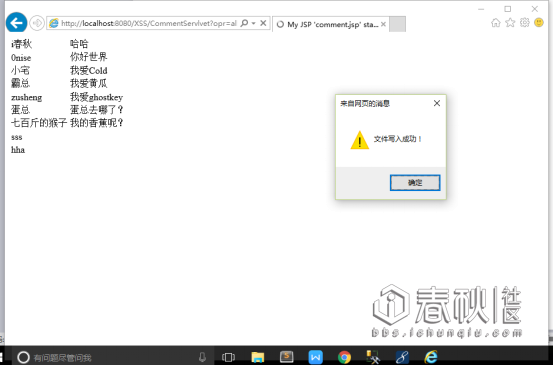
然后访问: http://localhost:8080/XSS/comment.jsp

文件写入成功。
root@3~#
留言内容:
[code]<script>location.href='http://bbs.ichunqiu.com'</script>[code]
访问页面:http://localhost:8080/XSS/comment.jsp

访问留言页面自动跳转到攻击者特定的网站。难道这就是传说中的劫持吗?
3.XSS防御方案
正所谓哪里有攻击,哪里就有防御。XSS一样,有攻击的方式,也有防御的方案。
EL表达式+JSTL标签库
EL(Expression Language):[size=12.0000pt]为了使JSP写起来更简单。表达式语言的灵感来自于ECMAScript和XPath表达式语语言,他提供了JSP中简化表达式的方法,让jsp代码更简单。
JSTL(JSP Standard Tag Library):开放源代码的JSP标签库。
实验一防御代码:
<%@ page language="java" import="java.util.*" pageEncoding="UTF-8"%>
<%@ taglib uri="http://java.sun.com/jsp/jstl/core" prefix="c" %>
<%
String path = request.getContextPath();
String basePath = request.getScheme()+"://"+request.getServerName()+":"+request.getServerPort()+path+"/";
%>
<!DOCTYPE HTML PUBLIC "-//W3C//DTD HTML 4.01 Transitional//EN">
<html>
<head>
<base href="<%=basePath%>">
<title>My JSP 'index.jsp' starting page</title>
<meta http-equiv="pragma" content="no-cache">
<meta http-equiv="cache-control" content="no-cache">
<meta http-equiv="expires" content="0">
<meta http-equiv="keywords" content="keyword1,keyword2,keyword3">
<meta http-equiv="description" content="This is my page">
</head>
<body>
<div style="margin: 0 auto">
<%
request.setCharacterEncoding("UTF-8");
String tmp = request.getParameter("opr");
//减速传入值是否为空
if(tmp == null){
out.print("111");
}else{
//转码
String opr = new String(tmp.getBytes("ISO-8859-1"),"utf-8");
request.setAttribute("name", opr);
%>
<c:out value="${requestScope.name }"></c:out>
<%
}
%>
我是内容
</div>
</body>
</html>
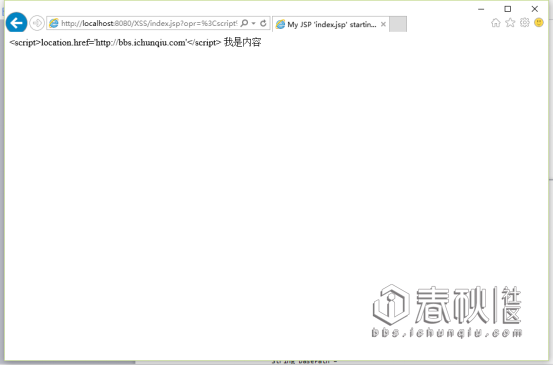
实验二防御代码:
<%@ page language="java" import="java.util.*,entity.*" pageEncoding="UTF-8"%> <%@ taglib uri="http://java.sun.com/jsp/jstl/core" prefix="c" %> <% String path = request.getContextPath(); String basePath = request.getScheme()+"://"+request.getServerName()+":"+request.getServerPort()+path+"/"; %>
<!DOCTYPE HTML PUBLIC "-//W3C//DTD HTML 4.01 Transitional//EN">
<html>
<head>
<base href="<%=basePath%>">
<title>My JSP 'comment.jsp' starting page</title>
<meta http-equiv="pragma" content="no-cache">
<meta http-equiv="cache-control" content="no-cache">
<meta http-equiv="expires" content="0">
<meta http-equiv="keywords" content="keyword1,keyword2,keyword3">
<meta http-equiv="description" content="This is my page">
</head>
<body>
<%
request.setCharacterEncoding("UTF-8");
if(request.getAttribute("all") == null){
request.getRequestDispatcher("CommentServlvet?opr=all").forward(request, response);
}
%>
<table>
<!-- 防御XSS方案 -->
<c:forEach var="x" items="${requestScope.all }">
<tr>
<td>
<c:out value="${x.getCName() }"></c:out>
</td>
<td>
<c:out value="${x.getCContext() }"></c:out>
</td>
</tr>
</c:forEach>
</table>
<form action="CommentServlvet?opr=add" method="post">
<textarea rows="5" cols="30" name="context"></textarea>
昵称:<input type="text" name="UName" />
<input type="submit" value="提交" />
</form>
</body>
</html>

结束语
技术无黑白,专研甚好。

